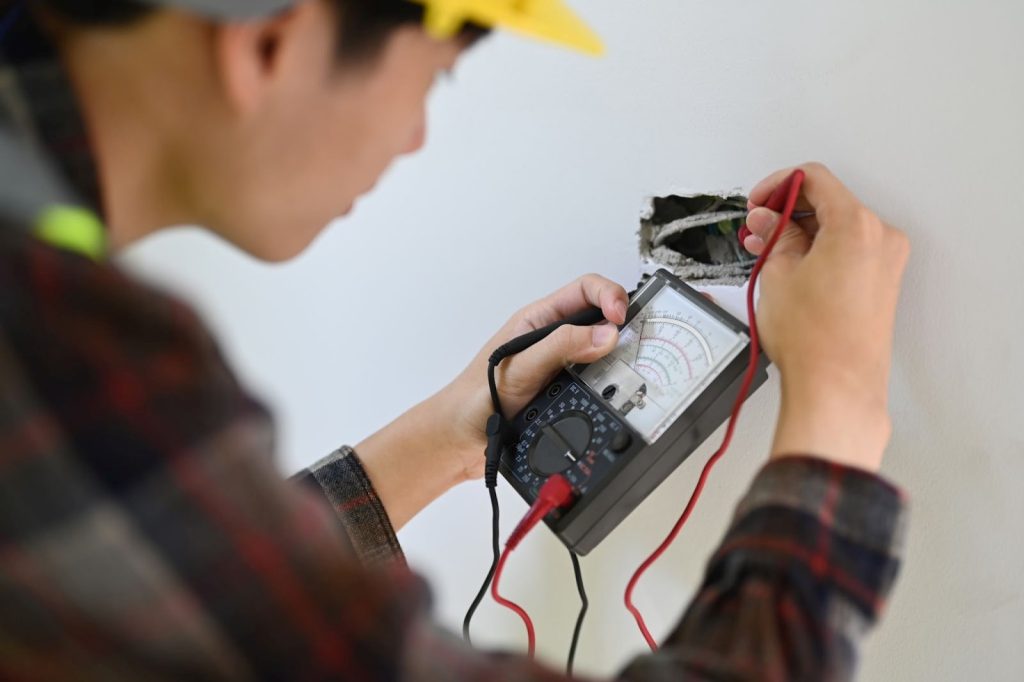Portable Appliance Testing, commonly referred to as PAT testing is the process of thoroughly examining your portable electrical appliances to ensure that they are completely safe to use. Getting your appliances PAT tested is an important and integral aspect of electrical safety. To comply with work regulations and legal requirements, you will need to make sure your electrical appliances are regularly tested.
The level of service inspection and how regularly your appliances need testing will depend on the type of equipment. For example, larger static items that are less likely to be damaged such as fridges or large printers need to be PAT tested less frequently than other smaller transportable electrical equipment which is more susceptible to damage such as portable computers or desk lamps.
To help you keep on top of inspections and testing, it is useful and important to label all the appliances that have been PAT tested. If you run a business, are a landlord, or work from home, you will be in charge of maintaining portable electric equipment and be tasked with their testing. To make that job a little easier, we explain the importance and usefulness of labeling your PAT tested equipment.
Get Your Appliances PAT Tested
Why is it important to label appliances after PAT testing?
Whilst it is not a legal requirement to label appliances after PAT testing, it helps in a variety of ways and should not be dismissed simply because it is not compulsory.
It is important to label appliances after PAT testing to:
- Keep everything organized
- Adhere to health and safety requirements
- Identify faulty equipment
Keep everything organized
Having a PAT label on your appliances helps to keep all your equipment organized and allows you to easily identify what tests have been carried out and what appliances have passed their tests. All you need to do is stick a PAT test label sticker to the plug of the equipment and you will instantly be able to see if they have passed or failed their PAT test.
It helps with maintaining portable appliances and ensures that when the time comes to retest any equipment, a quick look at the sticker will let you know which need to be tested and which electronic device must be disposed of due to safety concerns. It is good practice to get into the habit and label any tested appliances.
Adhere to health and safety requirements
The labels you stick on your equipment help to keep your PAT testing records organized, but they also help prove that you are adhering to all the relevant health and safety requirements. You will be able to easily identify when it was last tested and schedule a PAT test if needed.
If you had a last-minute unexpected health and safety check, you will be able to confidently show that all of your equipment adheres to the rules and regulations simply by showing inspectors the PAT tested stickers on all of the different types of appliances that require testing. Safety should be more than a surface-level requirement. As an employer or building owner, it is important to ensure the welfare of the people that use your electrical appliances.
Identify faulty equipment
In addition to having the green PAT tested stickers if an appliance passes its PAT test, there are also red PAT tested stickers to indicate that a piece of equipment has failed its test. This is useful for business owners and landlords who cannot immediately throw away or fix the problem as it lets employees know that certain pieces of equipment did not pass their PAT test and should therefore not be used. This helps keep everyone safe, especially in fast-paced busy working environments where solutions to electrical issues cannot always be put in place immediately.
What information will you find on a PAT label?
Here is the information you find on a PAT label:
- The Appliance ID
- Test Date
- Re-Test Date
- Test Engineer
- Company Details
1. Appliance ID
The appliance ID is what identifies the appliance. Each ID is unique to that specific piece of equipment which allows you to prevent confusion if you have identical appliances. For example, in large office blocks, almost all of the employees work on identical computers. To prevent confusion over their details, each has its own specific appliance ID.
2. Test Date
The date that the appliance was last tested is another key information that you will find on your PAT testing sticker. Knowing when your piece of equipment was last PAT tested can give users peace of mind when using the equipment. On the other hand, if it has been some time since your appliance has been tested, the user might flag a concern and inform you that it might be due for a test in the near future.3.
Re-Test Date
The re-test date is one of the most important pieces of information on a PAT test sticker other than the pass or fail sign as it ensures electrical safety testing is properly carried out at the correct time. Although the test date is useful, it does not let you know when it needs to be re-tested as each different type of electrical appliance needs a different period of time between tests.
By including the re-test date on the sticker, you will be able to make sure that you never go over the designated time for a check which ensures that you are keeping up to date with all the rules and regulations of testing electrical equipment.
4. Test Engineer
Having the name of the test engineer allows anyone who comes to inspect your appliances at a later date to make sure it was carried out by a competent person. It also provides reassurance to the individual using it that the service inspection was performed by a professional who can be held accountable.
5. Company Details
Including the company that the engineer worked for, provides comfort that the test was carried out by a reputable source. Companies that carry out portable appliance tests often include their details on the sticker so that if you encounter any problems with the equipment in the future, you can contact them and get your issues sorted as soon as possible. It also means that they can be easily contacted when you need to re-test your portable appliances.
The importance of being compliant with health and safety
Being fully compliant with health and safety regulations is necessary to ensure you are not compromising the safety of anyone in your working environment or property.
Faulty appliances are not just simply an inconvenience within the workplace, they can escalate into more serious, even occasionally fatal problems.
When not properly used or malfunctional, electricity can transform a seemingly mundane piece of equipment into a hazardous one, so you must monitor your electrical equipment at all times. In addition to the obvious need to be compliant with health and safety regulations to protect and preserve human life, it is also essential that you follow these rules from a legal standpoint.
Even if there are no issues or injuries in your workplace, if you are found to have been operating without following the correct guidelines, you can get into a lot of trouble and be liable for criminal negligence. If you are in charge of a business, run an institution such as a school, or are a landlord, we recommend PAT testing your equipment as soon as possible.
Something as seemingly insignificant as a warm computer can result in a devastating fire, so for your peace of mind, book your PAT test now. Our electrical experts will come to your domestic or commercial property and carry out a full PAT test. They will check plugs and wiring, carry out connection, insulation, and polarity tests amongst other key tests to ensure your electrical appliances are as safe as possible.


